Injury Prevention Report: Falls and Aboriginal Older Adults in NSW
VerifiedAdded on 2022/09/15
|12
|2263
|18
Report
AI Summary
This report focuses on injury prevention, specifically addressing the issue of falls among Aboriginal older adults in New South Wales. It highlights falls as a leading cause of injury, morbidity, and mortality in this demographic, often leading to GP visits and hospitalizations. The report provides epidemiological data, revealing higher fall rates among Aboriginal older adults compared to non-Aboriginals, though with shorter hospital stays for most injuries. It delves into the causes of falls, including slips, trips, and environmental hazards, along with their consequences like hip fractures and traumatic brain injuries. The report also examines the demographic profile of the target population, the impact of chronic conditions, and the challenges in accessing healthcare. It emphasizes the need for accurate data collection and highlights the importance of tailored injury prevention strategies to improve the health and well-being of Aboriginal older adults.
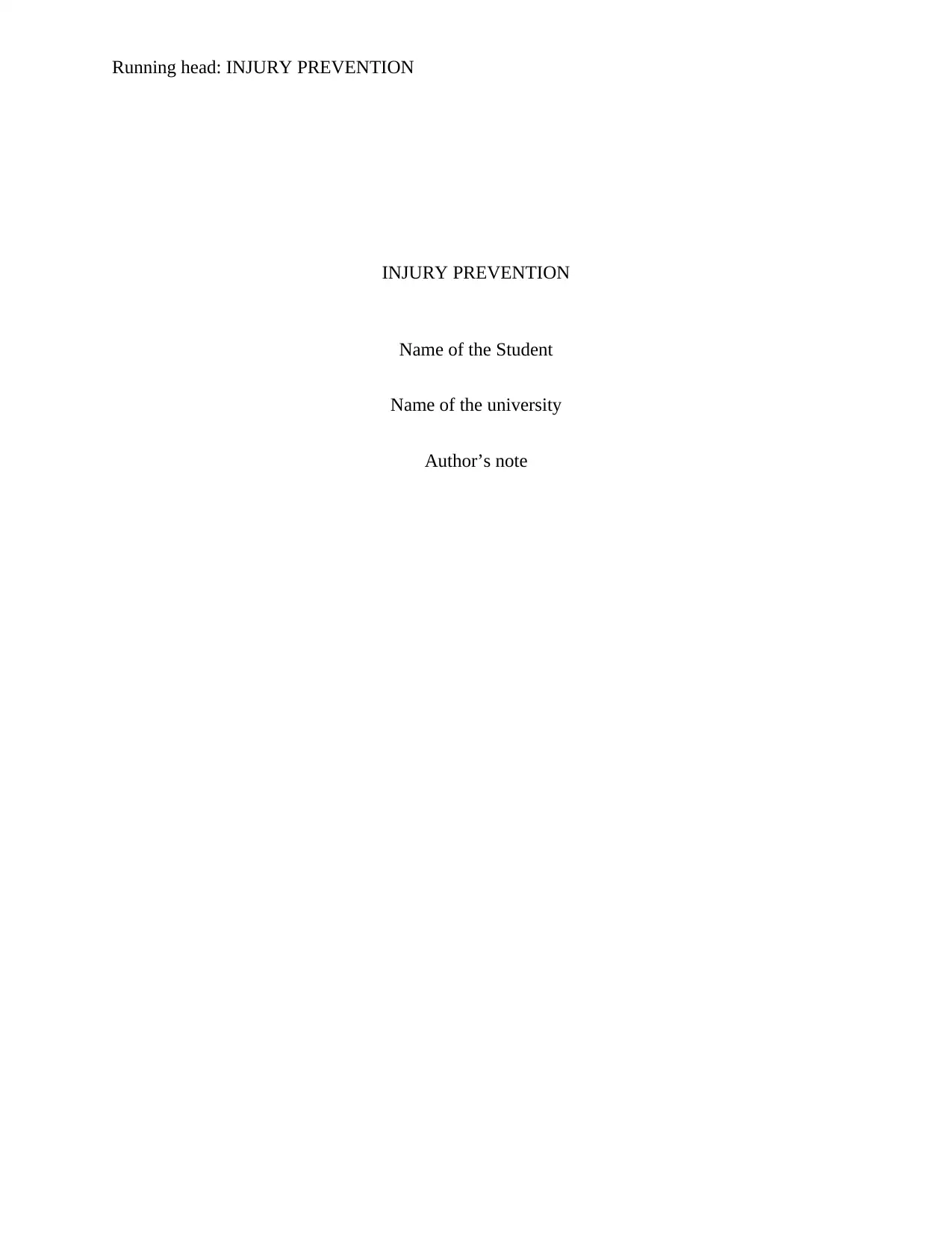
Running head: INJURY PREVENTION
INJURY PREVENTION
Name of the Student
Name of the university
Author’s note
INJURY PREVENTION
Name of the Student
Name of the university
Author’s note
Paraphrase This Document
Need a fresh take? Get an instant paraphrase of this document with our AI Paraphraser

1INJURY PREVENTION
Executive summary
Fall is the main cause of injury among the aboriginal older adults. The falls has been associated
with traumatic brain injury, medicines, slips and falls due to uneven or wet flooring. Injury
related to falls is associated with increased GP presentation and hospital admission. Falls results
in functional decline of the patients and reduces the quality of life. The rate of falls among the
older adults have been found to be higher in the aboriginals than the non-aboriginals. However,
they are less likely to remain under hospitalisation for a long time. An epidemiological profile of
this injury in New South Wales has been provided. However, accurate data needs regarding the
exact number of falls are still required.
Executive summary
Fall is the main cause of injury among the aboriginal older adults. The falls has been associated
with traumatic brain injury, medicines, slips and falls due to uneven or wet flooring. Injury
related to falls is associated with increased GP presentation and hospital admission. Falls results
in functional decline of the patients and reduces the quality of life. The rate of falls among the
older adults have been found to be higher in the aboriginals than the non-aboriginals. However,
they are less likely to remain under hospitalisation for a long time. An epidemiological profile of
this injury in New South Wales has been provided. However, accurate data needs regarding the
exact number of falls are still required.

2INJURY PREVENTION
CONTENTS
Introduction......................................................................................................................................2
Goal statement.................................................................................................................................2
Rationale for choosing this topic.....................................................................................................2
Demography for the target population.............................................................................................4
Conclusion.......................................................................................................................................8
References........................................................................................................................................9
CONTENTS
Introduction......................................................................................................................................2
Goal statement.................................................................................................................................2
Rationale for choosing this topic.....................................................................................................2
Demography for the target population.............................................................................................4
Conclusion.......................................................................................................................................8
References........................................................................................................................................9
⊘ This is a preview!⊘
Do you want full access?
Subscribe today to unlock all pages.

Trusted by 1+ million students worldwide
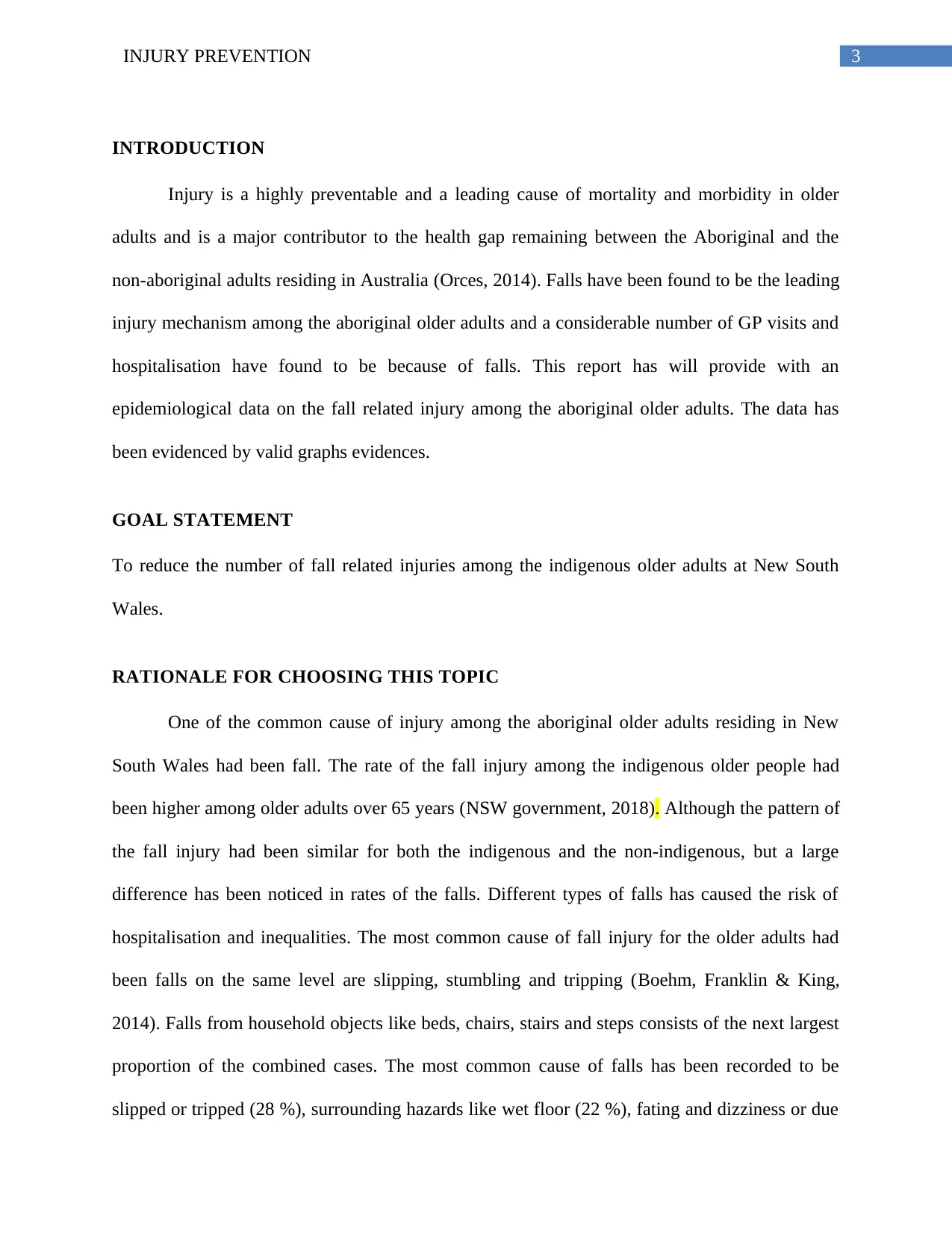
3INJURY PREVENTION
INTRODUCTION
Injury is a highly preventable and a leading cause of mortality and morbidity in older
adults and is a major contributor to the health gap remaining between the Aboriginal and the
non-aboriginal adults residing in Australia (Orces, 2014). Falls have been found to be the leading
injury mechanism among the aboriginal older adults and a considerable number of GP visits and
hospitalisation have found to be because of falls. This report has will provide with an
epidemiological data on the fall related injury among the aboriginal older adults. The data has
been evidenced by valid graphs evidences.
GOAL STATEMENT
To reduce the number of fall related injuries among the indigenous older adults at New South
Wales.
RATIONALE FOR CHOOSING THIS TOPIC
One of the common cause of injury among the aboriginal older adults residing in New
South Wales had been fall. The rate of the fall injury among the indigenous older people had
been higher among older adults over 65 years (NSW government, 2018). Although the pattern of
the fall injury had been similar for both the indigenous and the non-indigenous, but a large
difference has been noticed in rates of the falls. Different types of falls has caused the risk of
hospitalisation and inequalities. The most common cause of fall injury for the older adults had
been falls on the same level are slipping, stumbling and tripping (Boehm, Franklin & King,
2014). Falls from household objects like beds, chairs, stairs and steps consists of the next largest
proportion of the combined cases. The most common cause of falls has been recorded to be
slipped or tripped (28 %), surrounding hazards like wet floor (22 %), fating and dizziness or due
INTRODUCTION
Injury is a highly preventable and a leading cause of mortality and morbidity in older
adults and is a major contributor to the health gap remaining between the Aboriginal and the
non-aboriginal adults residing in Australia (Orces, 2014). Falls have been found to be the leading
injury mechanism among the aboriginal older adults and a considerable number of GP visits and
hospitalisation have found to be because of falls. This report has will provide with an
epidemiological data on the fall related injury among the aboriginal older adults. The data has
been evidenced by valid graphs evidences.
GOAL STATEMENT
To reduce the number of fall related injuries among the indigenous older adults at New South
Wales.
RATIONALE FOR CHOOSING THIS TOPIC
One of the common cause of injury among the aboriginal older adults residing in New
South Wales had been fall. The rate of the fall injury among the indigenous older people had
been higher among older adults over 65 years (NSW government, 2018). Although the pattern of
the fall injury had been similar for both the indigenous and the non-indigenous, but a large
difference has been noticed in rates of the falls. Different types of falls has caused the risk of
hospitalisation and inequalities. The most common cause of fall injury for the older adults had
been falls on the same level are slipping, stumbling and tripping (Boehm, Franklin & King,
2014). Falls from household objects like beds, chairs, stairs and steps consists of the next largest
proportion of the combined cases. The most common cause of falls has been recorded to be
slipped or tripped (28 %), surrounding hazards like wet floor (22 %), fating and dizziness or due
Paraphrase This Document
Need a fresh take? Get an instant paraphrase of this document with our AI Paraphraser

4INJURY PREVENTION
to the effect of certain medicines (22%) (NSW government, 2018). A series of falls in older
adults results in decreased functional independence and the quality of life. Some of the
consequences of falling can be devastating among the older adults. The fall risks increases with
age for a number of reasons, including the overall illness and the other environmental hazards
(NSW government, 2018). One of the most common injury that has been noticed is hip fracture.
The others are related to reduced mobility, loss of independence and the need to enter in to a
residential care. This has provided the rationale for choosing this topic related to injury
prevention.
Causes of hospitalized fall injury cases, by sex, Australia, 2014–15
to the effect of certain medicines (22%) (NSW government, 2018). A series of falls in older
adults results in decreased functional independence and the quality of life. Some of the
consequences of falling can be devastating among the older adults. The fall risks increases with
age for a number of reasons, including the overall illness and the other environmental hazards
(NSW government, 2018). One of the most common injury that has been noticed is hip fracture.
The others are related to reduced mobility, loss of independence and the need to enter in to a
residential care. This has provided the rationale for choosing this topic related to injury
prevention.
Causes of hospitalized fall injury cases, by sex, Australia, 2014–15
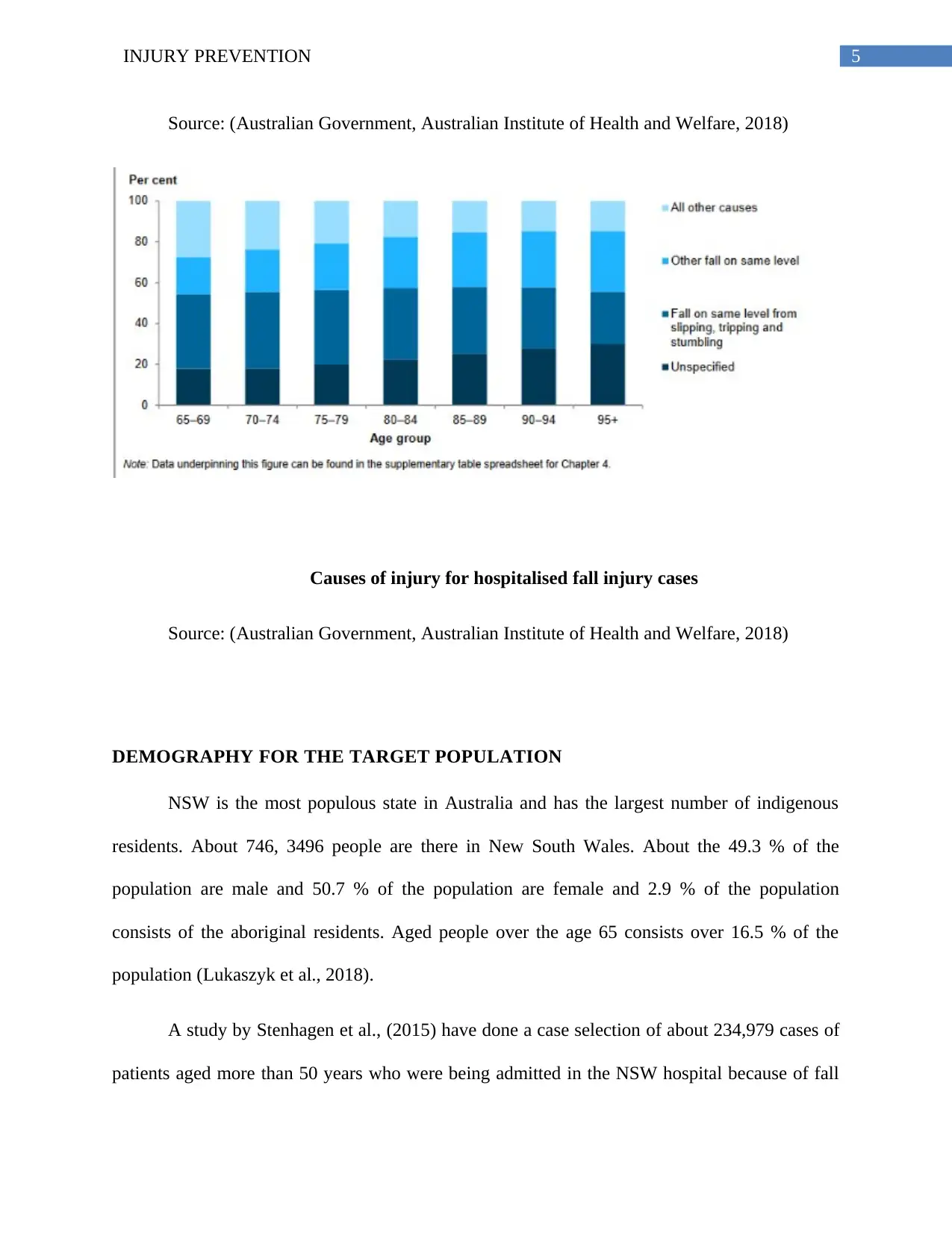
5INJURY PREVENTION
Source: (Australian Government, Australian Institute of Health and Welfare, 2018)
Causes of injury for hospitalised fall injury cases
Source: (Australian Government, Australian Institute of Health and Welfare, 2018)
DEMOGRAPHY FOR THE TARGET POPULATION
NSW is the most populous state in Australia and has the largest number of indigenous
residents. About 746, 3496 people are there in New South Wales. About the 49.3 % of the
population are male and 50.7 % of the population are female and 2.9 % of the population
consists of the aboriginal residents. Aged people over the age 65 consists over 16.5 % of the
population (Lukaszyk et al., 2018).
A study by Stenhagen et al., (2015) have done a case selection of about 234,979 cases of
patients aged more than 50 years who were being admitted in the NSW hospital because of fall
Source: (Australian Government, Australian Institute of Health and Welfare, 2018)
Causes of injury for hospitalised fall injury cases
Source: (Australian Government, Australian Institute of Health and Welfare, 2018)
DEMOGRAPHY FOR THE TARGET POPULATION
NSW is the most populous state in Australia and has the largest number of indigenous
residents. About 746, 3496 people are there in New South Wales. About the 49.3 % of the
population are male and 50.7 % of the population are female and 2.9 % of the population
consists of the aboriginal residents. Aged people over the age 65 consists over 16.5 % of the
population (Lukaszyk et al., 2018).
A study by Stenhagen et al., (2015) have done a case selection of about 234,979 cases of
patients aged more than 50 years who were being admitted in the NSW hospital because of fall
⊘ This is a preview!⊘
Do you want full access?
Subscribe today to unlock all pages.

Trusted by 1+ million students worldwide
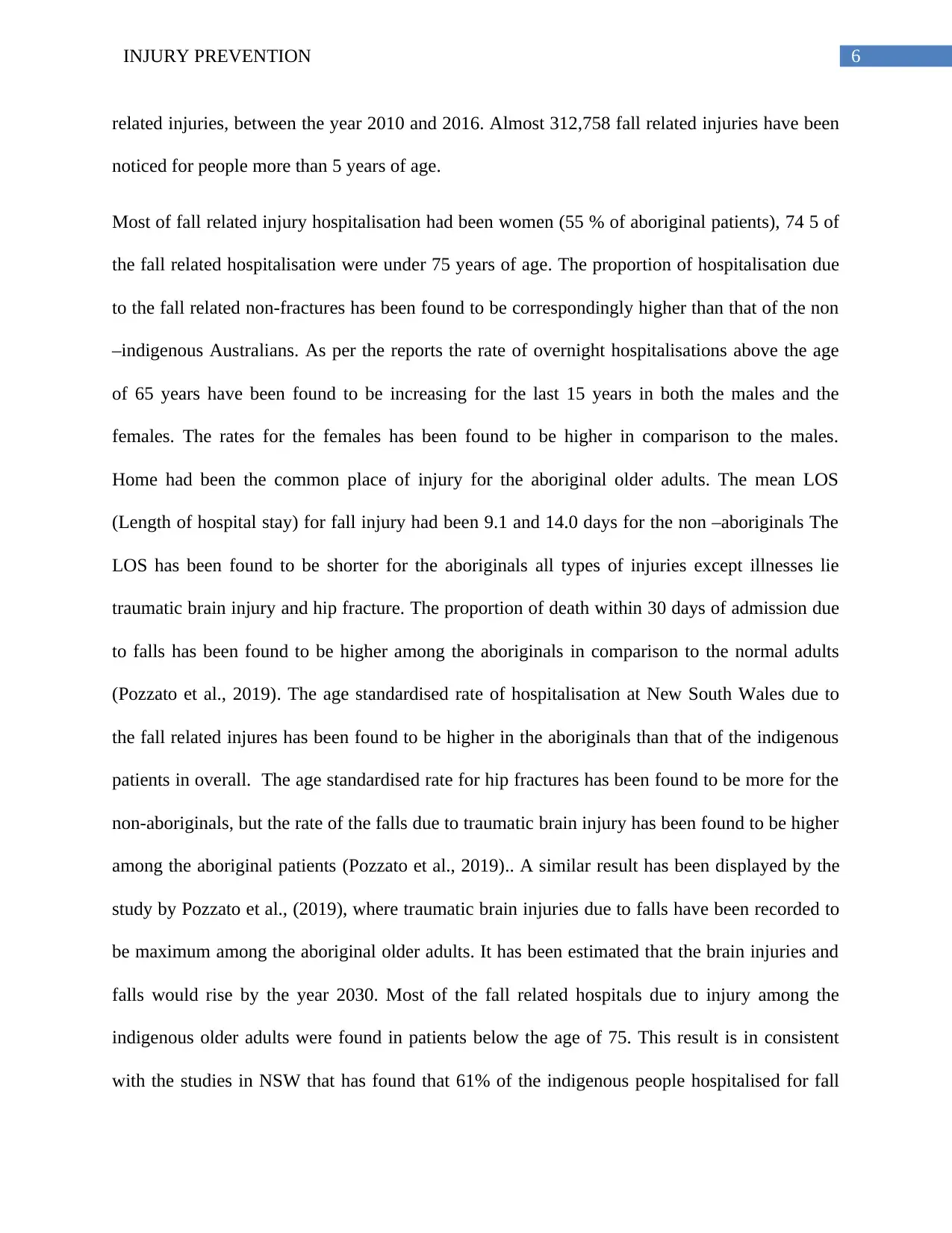
6INJURY PREVENTION
related injuries, between the year 2010 and 2016. Almost 312,758 fall related injuries have been
noticed for people more than 5 years of age.
Most of fall related injury hospitalisation had been women (55 % of aboriginal patients), 74 5 of
the fall related hospitalisation were under 75 years of age. The proportion of hospitalisation due
to the fall related non-fractures has been found to be correspondingly higher than that of the non
–indigenous Australians. As per the reports the rate of overnight hospitalisations above the age
of 65 years have been found to be increasing for the last 15 years in both the males and the
females. The rates for the females has been found to be higher in comparison to the males.
Home had been the common place of injury for the aboriginal older adults. The mean LOS
(Length of hospital stay) for fall injury had been 9.1 and 14.0 days for the non –aboriginals The
LOS has been found to be shorter for the aboriginals all types of injuries except illnesses lie
traumatic brain injury and hip fracture. The proportion of death within 30 days of admission due
to falls has been found to be higher among the aboriginals in comparison to the normal adults
(Pozzato et al., 2019). The age standardised rate of hospitalisation at New South Wales due to
the fall related injures has been found to be higher in the aboriginals than that of the indigenous
patients in overall. The age standardised rate for hip fractures has been found to be more for the
non-aboriginals, but the rate of the falls due to traumatic brain injury has been found to be higher
among the aboriginal patients (Pozzato et al., 2019).. A similar result has been displayed by the
study by Pozzato et al., (2019), where traumatic brain injuries due to falls have been recorded to
be maximum among the aboriginal older adults. It has been estimated that the brain injuries and
falls would rise by the year 2030. Most of the fall related hospitals due to injury among the
indigenous older adults were found in patients below the age of 75. This result is in consistent
with the studies in NSW that has found that 61% of the indigenous people hospitalised for fall
related injuries, between the year 2010 and 2016. Almost 312,758 fall related injuries have been
noticed for people more than 5 years of age.
Most of fall related injury hospitalisation had been women (55 % of aboriginal patients), 74 5 of
the fall related hospitalisation were under 75 years of age. The proportion of hospitalisation due
to the fall related non-fractures has been found to be correspondingly higher than that of the non
–indigenous Australians. As per the reports the rate of overnight hospitalisations above the age
of 65 years have been found to be increasing for the last 15 years in both the males and the
females. The rates for the females has been found to be higher in comparison to the males.
Home had been the common place of injury for the aboriginal older adults. The mean LOS
(Length of hospital stay) for fall injury had been 9.1 and 14.0 days for the non –aboriginals The
LOS has been found to be shorter for the aboriginals all types of injuries except illnesses lie
traumatic brain injury and hip fracture. The proportion of death within 30 days of admission due
to falls has been found to be higher among the aboriginals in comparison to the normal adults
(Pozzato et al., 2019). The age standardised rate of hospitalisation at New South Wales due to
the fall related injures has been found to be higher in the aboriginals than that of the indigenous
patients in overall. The age standardised rate for hip fractures has been found to be more for the
non-aboriginals, but the rate of the falls due to traumatic brain injury has been found to be higher
among the aboriginal patients (Pozzato et al., 2019).. A similar result has been displayed by the
study by Pozzato et al., (2019), where traumatic brain injuries due to falls have been recorded to
be maximum among the aboriginal older adults. It has been estimated that the brain injuries and
falls would rise by the year 2030. Most of the fall related hospitals due to injury among the
indigenous older adults were found in patients below the age of 75. This result is in consistent
with the studies in NSW that has found that 61% of the indigenous people hospitalised for fall
Paraphrase This Document
Need a fresh take? Get an instant paraphrase of this document with our AI Paraphraser
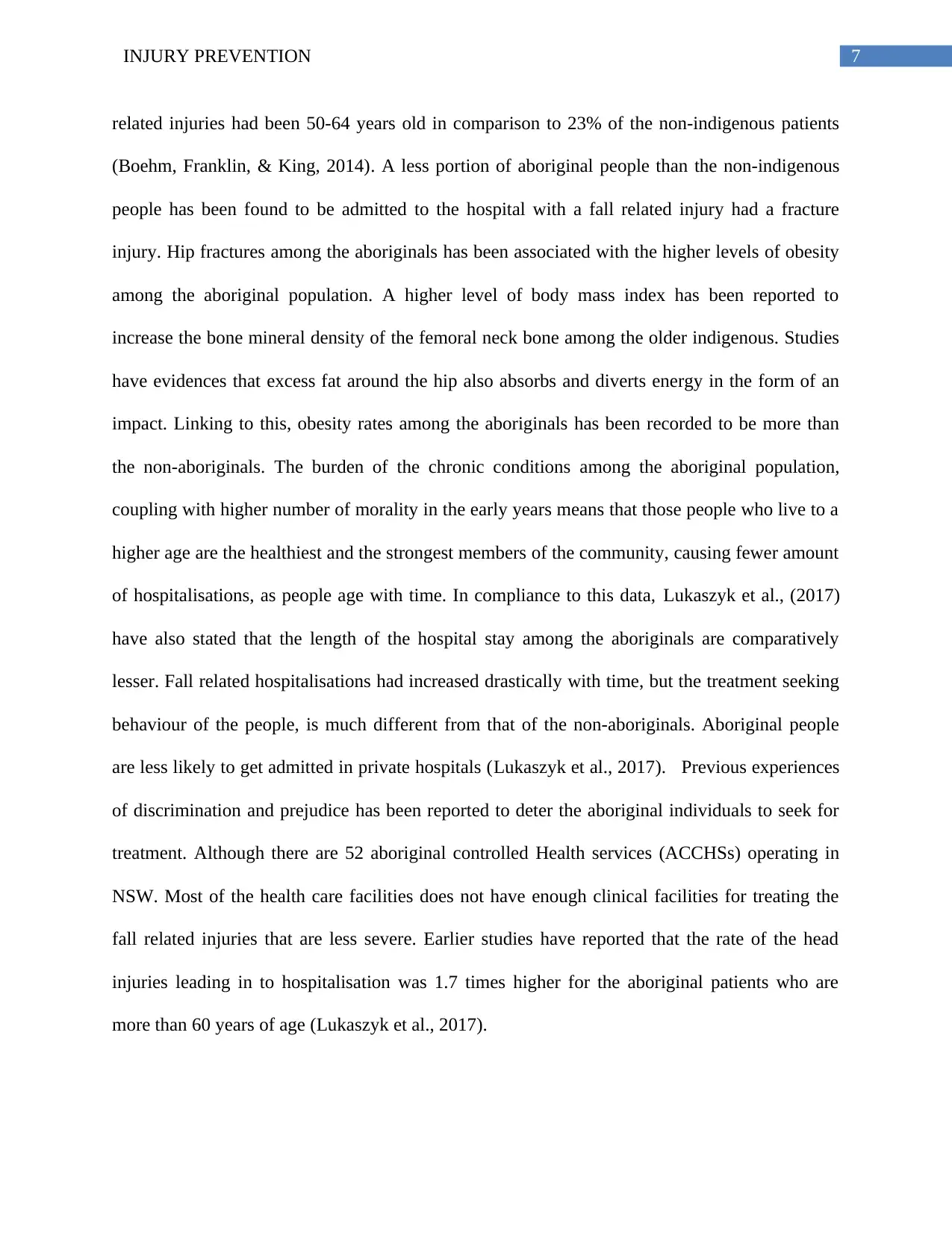
7INJURY PREVENTION
related injuries had been 50-64 years old in comparison to 23% of the non-indigenous patients
(Boehm, Franklin, & King, 2014). A less portion of aboriginal people than the non-indigenous
people has been found to be admitted to the hospital with a fall related injury had a fracture
injury. Hip fractures among the aboriginals has been associated with the higher levels of obesity
among the aboriginal population. A higher level of body mass index has been reported to
increase the bone mineral density of the femoral neck bone among the older indigenous. Studies
have evidences that excess fat around the hip also absorbs and diverts energy in the form of an
impact. Linking to this, obesity rates among the aboriginals has been recorded to be more than
the non-aboriginals. The burden of the chronic conditions among the aboriginal population,
coupling with higher number of morality in the early years means that those people who live to a
higher age are the healthiest and the strongest members of the community, causing fewer amount
of hospitalisations, as people age with time. In compliance to this data, Lukaszyk et al., (2017)
have also stated that the length of the hospital stay among the aboriginals are comparatively
lesser. Fall related hospitalisations had increased drastically with time, but the treatment seeking
behaviour of the people, is much different from that of the non-aboriginals. Aboriginal people
are less likely to get admitted in private hospitals (Lukaszyk et al., 2017). Previous experiences
of discrimination and prejudice has been reported to deter the aboriginal individuals to seek for
treatment. Although there are 52 aboriginal controlled Health services (ACCHSs) operating in
NSW. Most of the health care facilities does not have enough clinical facilities for treating the
fall related injuries that are less severe. Earlier studies have reported that the rate of the head
injuries leading in to hospitalisation was 1.7 times higher for the aboriginal patients who are
more than 60 years of age (Lukaszyk et al., 2017).
related injuries had been 50-64 years old in comparison to 23% of the non-indigenous patients
(Boehm, Franklin, & King, 2014). A less portion of aboriginal people than the non-indigenous
people has been found to be admitted to the hospital with a fall related injury had a fracture
injury. Hip fractures among the aboriginals has been associated with the higher levels of obesity
among the aboriginal population. A higher level of body mass index has been reported to
increase the bone mineral density of the femoral neck bone among the older indigenous. Studies
have evidences that excess fat around the hip also absorbs and diverts energy in the form of an
impact. Linking to this, obesity rates among the aboriginals has been recorded to be more than
the non-aboriginals. The burden of the chronic conditions among the aboriginal population,
coupling with higher number of morality in the early years means that those people who live to a
higher age are the healthiest and the strongest members of the community, causing fewer amount
of hospitalisations, as people age with time. In compliance to this data, Lukaszyk et al., (2017)
have also stated that the length of the hospital stay among the aboriginals are comparatively
lesser. Fall related hospitalisations had increased drastically with time, but the treatment seeking
behaviour of the people, is much different from that of the non-aboriginals. Aboriginal people
are less likely to get admitted in private hospitals (Lukaszyk et al., 2017). Previous experiences
of discrimination and prejudice has been reported to deter the aboriginal individuals to seek for
treatment. Although there are 52 aboriginal controlled Health services (ACCHSs) operating in
NSW. Most of the health care facilities does not have enough clinical facilities for treating the
fall related injuries that are less severe. Earlier studies have reported that the rate of the head
injuries leading in to hospitalisation was 1.7 times higher for the aboriginal patients who are
more than 60 years of age (Lukaszyk et al., 2017).
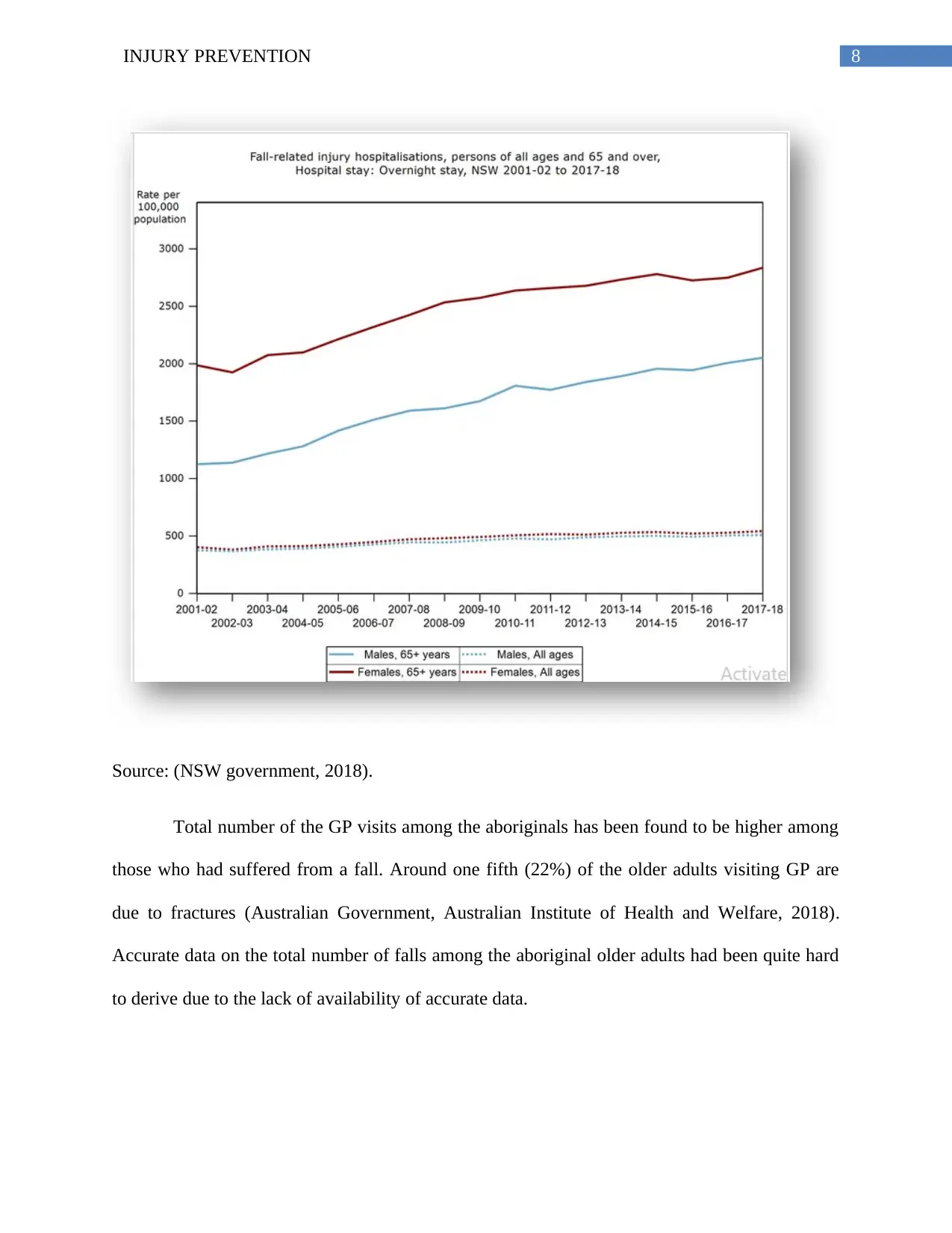
8INJURY PREVENTION
Source: (NSW government, 2018).
Total number of the GP visits among the aboriginals has been found to be higher among
those who had suffered from a fall. Around one fifth (22%) of the older adults visiting GP are
due to fractures (Australian Government, Australian Institute of Health and Welfare, 2018).
Accurate data on the total number of falls among the aboriginal older adults had been quite hard
to derive due to the lack of availability of accurate data.
Source: (NSW government, 2018).
Total number of the GP visits among the aboriginals has been found to be higher among
those who had suffered from a fall. Around one fifth (22%) of the older adults visiting GP are
due to fractures (Australian Government, Australian Institute of Health and Welfare, 2018).
Accurate data on the total number of falls among the aboriginal older adults had been quite hard
to derive due to the lack of availability of accurate data.
⊘ This is a preview!⊘
Do you want full access?
Subscribe today to unlock all pages.

Trusted by 1+ million students worldwide
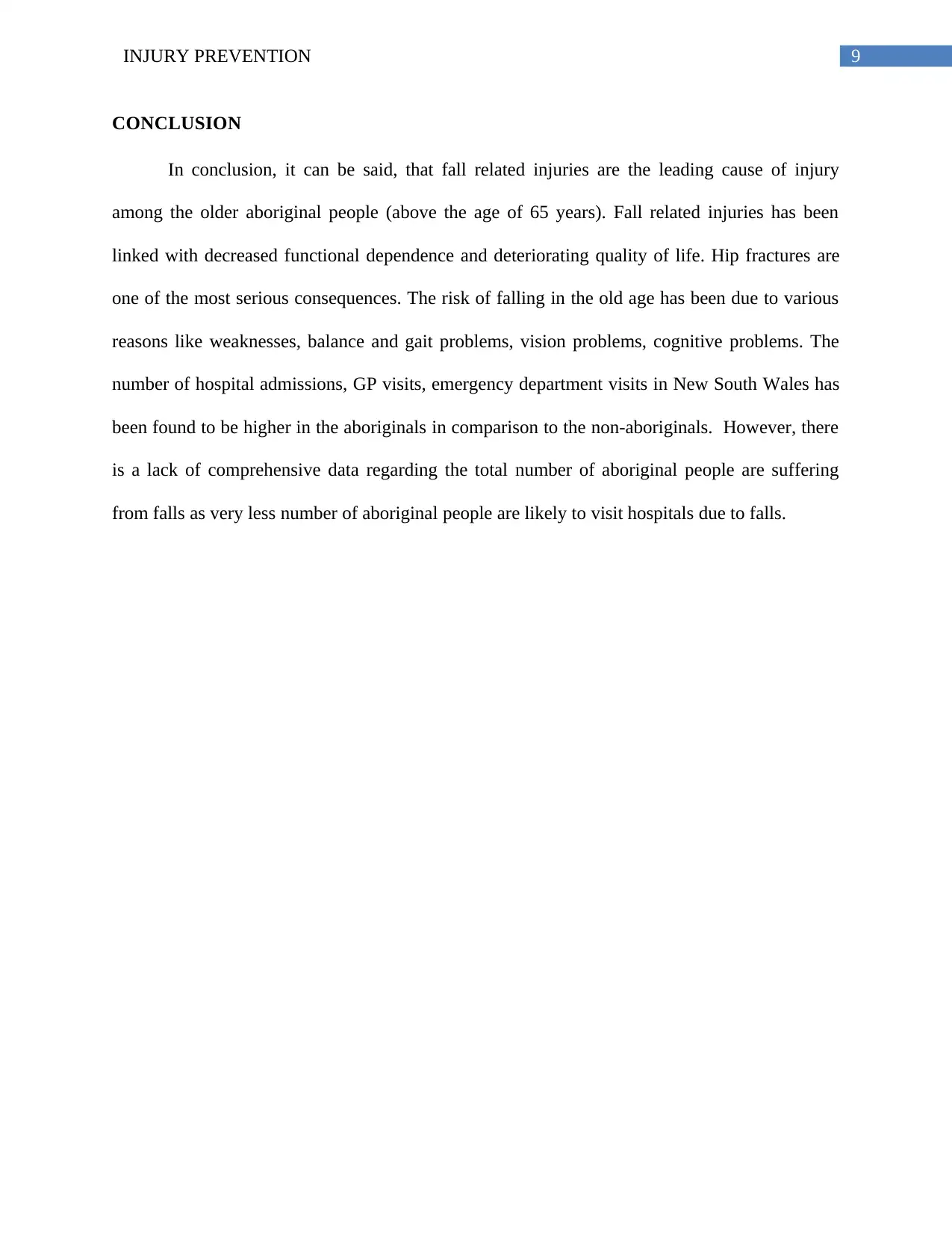
9INJURY PREVENTION
CONCLUSION
In conclusion, it can be said, that fall related injuries are the leading cause of injury
among the older aboriginal people (above the age of 65 years). Fall related injuries has been
linked with decreased functional dependence and deteriorating quality of life. Hip fractures are
one of the most serious consequences. The risk of falling in the old age has been due to various
reasons like weaknesses, balance and gait problems, vision problems, cognitive problems. The
number of hospital admissions, GP visits, emergency department visits in New South Wales has
been found to be higher in the aboriginals in comparison to the non-aboriginals. However, there
is a lack of comprehensive data regarding the total number of aboriginal people are suffering
from falls as very less number of aboriginal people are likely to visit hospitals due to falls.
CONCLUSION
In conclusion, it can be said, that fall related injuries are the leading cause of injury
among the older aboriginal people (above the age of 65 years). Fall related injuries has been
linked with decreased functional dependence and deteriorating quality of life. Hip fractures are
one of the most serious consequences. The risk of falling in the old age has been due to various
reasons like weaknesses, balance and gait problems, vision problems, cognitive problems. The
number of hospital admissions, GP visits, emergency department visits in New South Wales has
been found to be higher in the aboriginals in comparison to the non-aboriginals. However, there
is a lack of comprehensive data regarding the total number of aboriginal people are suffering
from falls as very less number of aboriginal people are likely to visit hospitals due to falls.
Paraphrase This Document
Need a fresh take? Get an instant paraphrase of this document with our AI Paraphraser
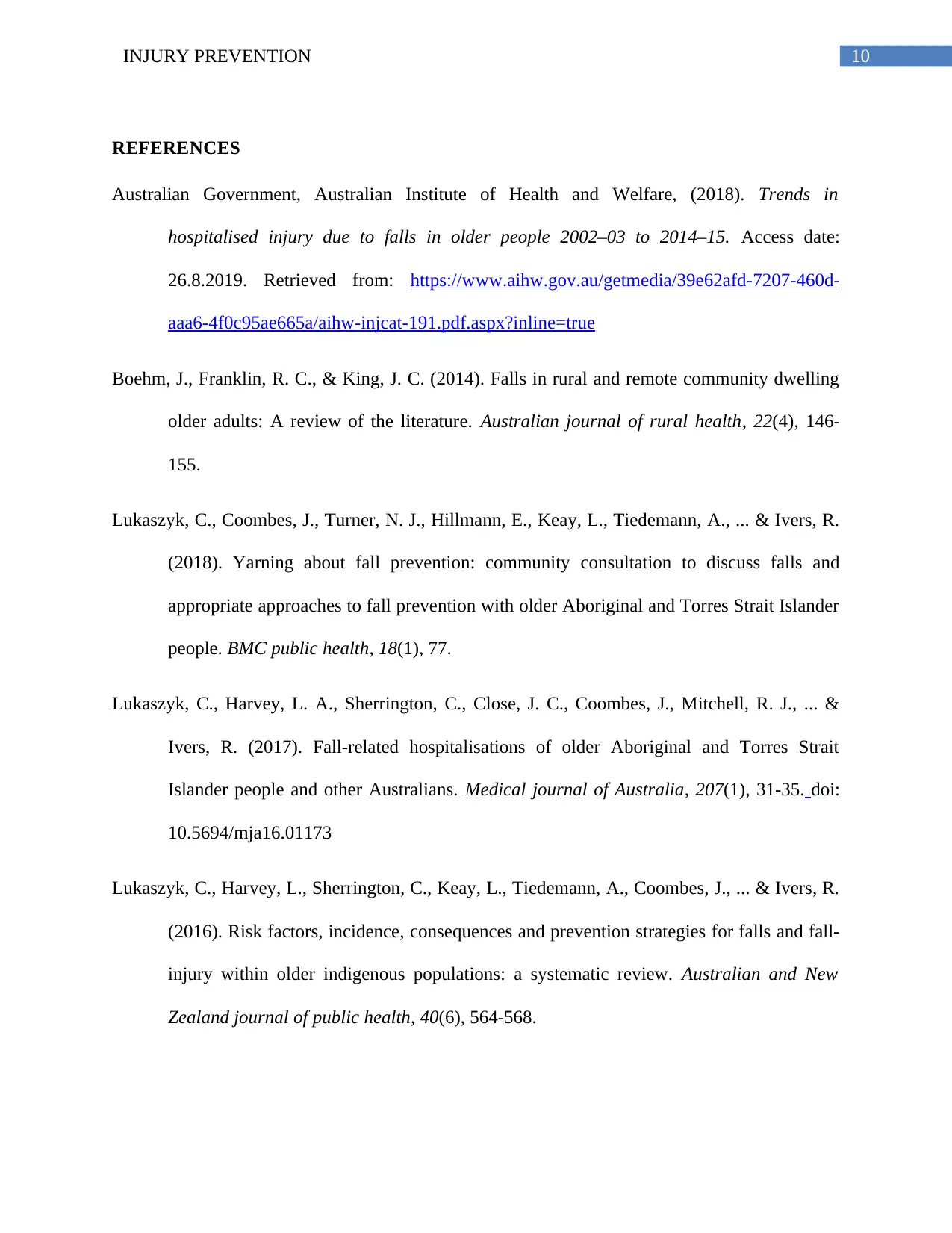
10INJURY PREVENTION
REFERENCES
Australian Government, Australian Institute of Health and Welfare, (2018). Trends in
hospitalised injury due to falls in older people 2002–03 to 2014–15. Access date:
26.8.2019. Retrieved from: https://www.aihw.gov.au/getmedia/39e62afd-7207-460d-
aaa6-4f0c95ae665a/aihw-injcat-191.pdf.aspx?inline=true
Boehm, J., Franklin, R. C., & King, J. C. (2014). Falls in rural and remote community dwelling
older adults: A review of the literature. Australian journal of rural health, 22(4), 146-
155.
Lukaszyk, C., Coombes, J., Turner, N. J., Hillmann, E., Keay, L., Tiedemann, A., ... & Ivers, R.
(2018). Yarning about fall prevention: community consultation to discuss falls and
appropriate approaches to fall prevention with older Aboriginal and Torres Strait Islander
people. BMC public health, 18(1), 77.
Lukaszyk, C., Harvey, L. A., Sherrington, C., Close, J. C., Coombes, J., Mitchell, R. J., ... &
Ivers, R. (2017). Fall‐related hospitalisations of older Aboriginal and Torres Strait
Islander people and other Australians. Medical journal of Australia, 207(1), 31-35. doi:
10.5694/mja16.01173
Lukaszyk, C., Harvey, L., Sherrington, C., Keay, L., Tiedemann, A., Coombes, J., ... & Ivers, R.
(2016). Risk factors, incidence, consequences and prevention strategies for falls and fall‐
injury within older indigenous populations: a systematic review. Australian and New
Zealand journal of public health, 40(6), 564-568.
REFERENCES
Australian Government, Australian Institute of Health and Welfare, (2018). Trends in
hospitalised injury due to falls in older people 2002–03 to 2014–15. Access date:
26.8.2019. Retrieved from: https://www.aihw.gov.au/getmedia/39e62afd-7207-460d-
aaa6-4f0c95ae665a/aihw-injcat-191.pdf.aspx?inline=true
Boehm, J., Franklin, R. C., & King, J. C. (2014). Falls in rural and remote community dwelling
older adults: A review of the literature. Australian journal of rural health, 22(4), 146-
155.
Lukaszyk, C., Coombes, J., Turner, N. J., Hillmann, E., Keay, L., Tiedemann, A., ... & Ivers, R.
(2018). Yarning about fall prevention: community consultation to discuss falls and
appropriate approaches to fall prevention with older Aboriginal and Torres Strait Islander
people. BMC public health, 18(1), 77.
Lukaszyk, C., Harvey, L. A., Sherrington, C., Close, J. C., Coombes, J., Mitchell, R. J., ... &
Ivers, R. (2017). Fall‐related hospitalisations of older Aboriginal and Torres Strait
Islander people and other Australians. Medical journal of Australia, 207(1), 31-35. doi:
10.5694/mja16.01173
Lukaszyk, C., Harvey, L., Sherrington, C., Keay, L., Tiedemann, A., Coombes, J., ... & Ivers, R.
(2016). Risk factors, incidence, consequences and prevention strategies for falls and fall‐
injury within older indigenous populations: a systematic review. Australian and New
Zealand journal of public health, 40(6), 564-568.

11INJURY PREVENTION
NSW government, (2018).HealthStats. Access date: 26.8.2019. Retrieved from:
http://www.healthstats.nsw.gov.au/Indicator/bod_falloldhos
Orces, C. H. (2014). Prevalence and determinants of fall-related injuries among older adults in
Ecuador. Current gerontology and geriatrics research, 2014.
Pozzato, I., Tate, R. L., Rosenkoetter, U., & Cameron, I. D. (2019). Epidemiology of hospitalised
traumatic brain injury in the state of New South Wales, Australia: a population‐based
study. Australian and New Zealand journal of public health.
https://doi.org/10.1111/1753-6405.12878
Stenhagen, M., Ekström, H., Nordell, E., & Elmståhl, S. (2014). Accidental falls, health-related
quality of life and life satisfaction: a prospective study of the general elderly population.
Archives of gerontology and geriatrics, 58(1), 95-100.
NSW government, (2018).HealthStats. Access date: 26.8.2019. Retrieved from:
http://www.healthstats.nsw.gov.au/Indicator/bod_falloldhos
Orces, C. H. (2014). Prevalence and determinants of fall-related injuries among older adults in
Ecuador. Current gerontology and geriatrics research, 2014.
Pozzato, I., Tate, R. L., Rosenkoetter, U., & Cameron, I. D. (2019). Epidemiology of hospitalised
traumatic brain injury in the state of New South Wales, Australia: a population‐based
study. Australian and New Zealand journal of public health.
https://doi.org/10.1111/1753-6405.12878
Stenhagen, M., Ekström, H., Nordell, E., & Elmståhl, S. (2014). Accidental falls, health-related
quality of life and life satisfaction: a prospective study of the general elderly population.
Archives of gerontology and geriatrics, 58(1), 95-100.
⊘ This is a preview!⊘
Do you want full access?
Subscribe today to unlock all pages.

Trusted by 1+ million students worldwide
1 out of 12
Related Documents
Your All-in-One AI-Powered Toolkit for Academic Success.
+13062052269
info@desklib.com
Available 24*7 on WhatsApp / Email
![[object Object]](/_next/static/media/star-bottom.7253800d.svg)
Unlock your academic potential
Copyright © 2020–2025 A2Z Services. All Rights Reserved. Developed and managed by ZUCOL.





